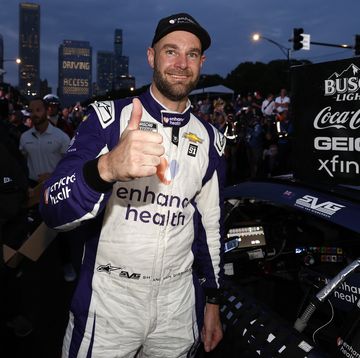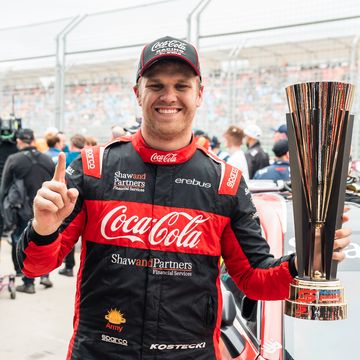- Beginning with the July 9 Atlanta race, the car’s front clip will be softened so it will be more collapsible during a crash.
- A 0.060-inch steel plate is being installed in the right-side door due to this spring’s crash at Talladega involving Kyle Larson and Ryan Preece
- In 2022 the sanctioning body’s Cup Series not only experienced more crashes than the historical norm, but “higher severity crashes."
After a season of NASCAR Cup drivers enduring the most “severe crashes” since the current data system was enacted in 2011, numerous changes are being implemented to the current car in an effort to curtail the severity of the race collisions.
Beginning with the July 9 Atlanta race, the car’s front clip will be softened so it will be more collapsible during a crash while its right side will be strengthened. A 0.060-inch steel plate is being installed in the right-side door due to this spring’s crash at Talladega involving Kyle Larson and Ryan Preece. Previously, the door plate was constructed of aluminum.
NASCAR vice president Safety Engineering Dr. John Patalak said that in 2022 the sanctioning body’s Cup Series not only experienced more crashes than the historical norm, but “higher severity crashes.”
CLICK HERE TO SEE THE KYLE LARSON-RYAN PREECE CRASH
“Cars were hitting walls at higher speeds at higher angles than we have historically,” Patalak said. “It didn’t have anything to do with the car itself. We had speeds and angles in 2022 that we have not had historically that were very challenging to the car.
“For whatever reason, a combination of things … car setups and everything being new and the feel of the car for the drivers … we had crashes that just had not occurred all the way back through 2011 in Xfinity or Cup. They were really big, severe crashes.”
The car’s new right-side requirements were the result of the Talladega crash. The front clip changes had been under development for several months. NASCAR is allowing teams to modify existing parts in their inventory. For those unable to modify the parts, Technique Chassis, the vendor that supplies the current chassis, front, center, and rear body mounts, is available. Also, NASCAR will be involved in helping teams absorb the cost required to make the modifications.
NASCAR vice president Vehicle Design Brandon Thomas doesn’t believe a “pandora’s box” is being opened by allowing the teams to make the modifications because “everybody has a vested interest in making this work.”
Drivers complained last year about the hard hits their bodies were enduring during the current car’s inaugural season. Kurt Busch and Alex Bowman both suffered concussions in single-car accidents last year. Bowman returned to racing, but Busch has yet to drive a race car in competition. Patalak cited Ross Chastain’s crash during practice at Auto Club Speedway early in 2022 and then Cody Ware at Texas, later that same year as severe hits.
“Just really, really big hits that we had to create new bars on our graphs for when we go all the way back to 2011,” Patalak said. “We were surprised by that, by the severity of the crashes.”
This year, Patalak said there was a 59-mph velocity difference in Larson’s Chevrolet and Preece’s Ford when Preece T-boned Larson in the passenger door during May’s Talladega race.
“That’s really hard to find that on the race track,” Patalak said. “What I mean by that is a difference of almost 60 miles an hour between two cars. That’s why this crash was so severe.
“It’s very rare in our racing that you have cars with (that type of speed difference). So, when those types of impacts occur, it’s very challenging to both cars.”
Patalak noted their studies at NASCAR’s R&D Center in Concord, North Carolina, weren’t confined to the car’s integrity.
“We have projects running on head-and-neck restraints, and helmets and head surround foams and seat inserts and seat mounting,” Patalak said. “Each driver’s restraint system is very customized. We routinely reach out to drivers if we see something that is an opportunity for improvement. I’ve reached out to drivers recently about helmet fit, about having chin straps tight. We had a HANS clip put on backwards.”
Patalak said they also conducted an in-depth study of Blaine Perkins’ barrel rolling crash in the NASCAR Xfinity race at Talladega.
“In fact, we went back to Dr. James Raddin and had him consult with us on the Xfinity barrel roll,” Patalak said. “He was the lead author on the (Dale) Earnhardt investigation. The reason we went to him was because he had very specific experience with fighter pilots who experienced those types of long-sustained accelerations. Now, the acceleration levels are low, but they’re sustained for a very long amount of time like a second; whereas a crash is a tenth of a second.”
Patalak said Perkins experienced low-level accelerations during his two separate barrel rolls. He said Perkins came to the NASCAR R&D Center and they walked him through the data and his restraint system.
“Things that weren’t necessarily wrong, but things we could have done better, that the driver could have done better to reduce those accelerations on his body,” Patalak said.














